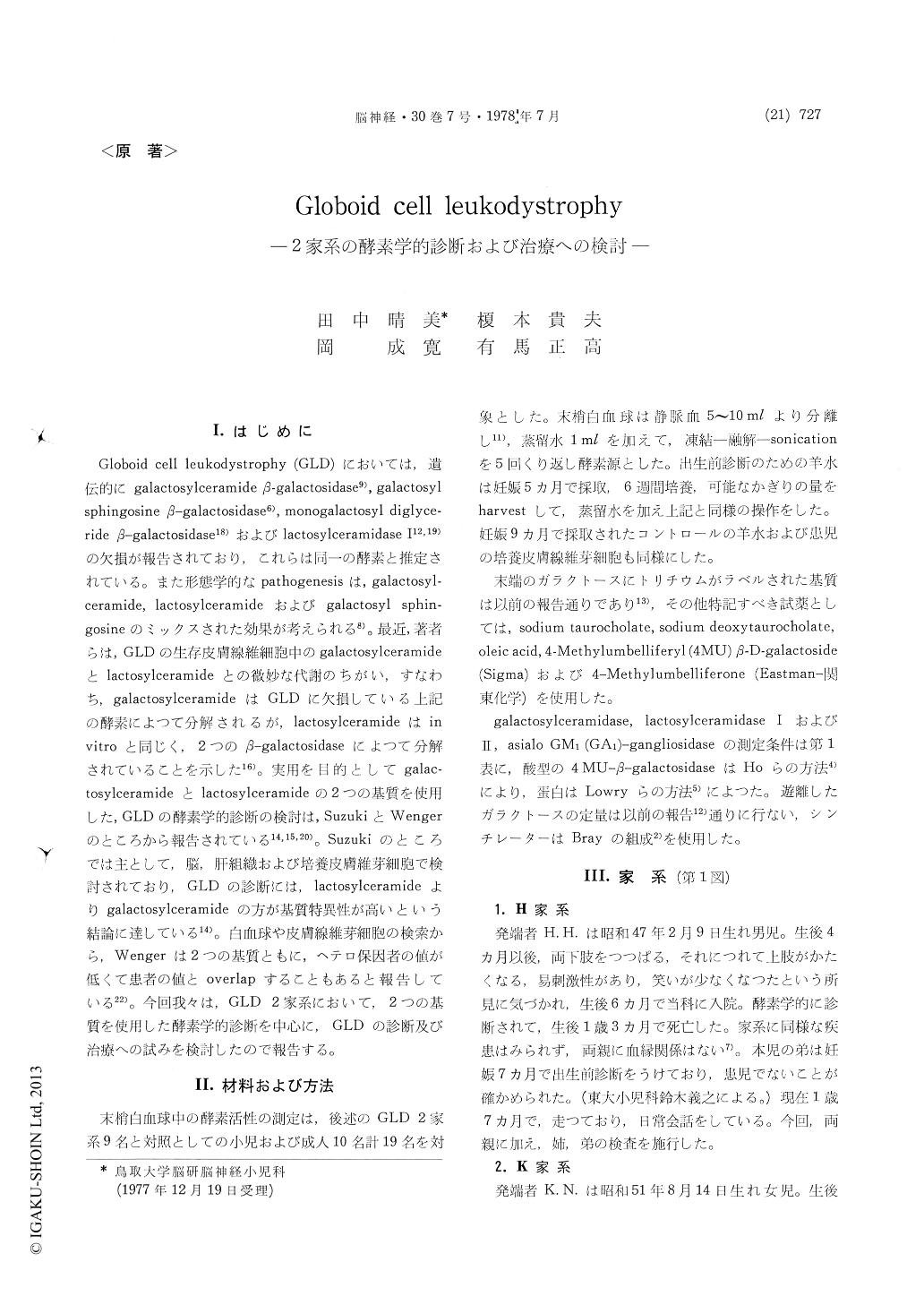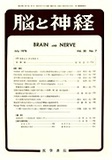Japanese
English
- 有料閲覧
- Abstract 文献概要
- 1ページ目 Look Inside
I.はじめに
Globoid cell leukodystrophy (GLD)においては,遺伝的にgalactosylceramideβ—galactosidase9),galactosylsphingosineβ—galactosidase6),monogalactosyl diglyce—rideβ—galactosidase18)およびlactosylceramidase I12,19)の欠損が報舎されており,これらは同一の酵素と推定されている。また形態学的なpathogenesisは,galactosyl—ceramide,lactosylceramideおよびgalactosyl sphin—gosineのミックスされた効果が考えられる8)。最近,著者らは,GLDの生存皮膚線維細胞中のgalactosylceramideとlactosylceramideとの微妙な代謝のちがい,すなわち,galactosylceramideはGLDに欠損している上記の酵素によつて分解されるが,lactosytceramideはinvitroと同じく,2つのβ—galactosidaseによつて分解されていることを示した16)。実用を目的としてgalac—tosylceramideとlactosylceramideの2つの基質を使用した,GLDの酵素学的診断の検討は,SuzukiとWengerのところから報告されている14,15,20)。Suzukiのところでは主として,脳,肝組織および培養皮膚維芽細胞で検討されており,GLDの診断には,lactosylcerarmideよりgalactosylceramideの方が基質特異性が高いという結論に達している14)。白血球や皮膚線維芽細胞の検索から,Wengerは2つの基質ともに,ヘテロ保因者の値が低くて患者の値とoverlapすることもあると報告している22)。
Globoid cell leukodystrophy (GLD) is characterized by a genetic deficiency of galactosylceramidase. Galactosylceramide is a relatively specific substrate for galactosylceramidase, but lactosylceramide is hydrolyzed not only by galactosylceramide (lacto-sylceramidase I) but also by another β-galactosidase, GM1-ganglioside β-galactosidase (lactosylceramidase II). In order to obtain some insight into the practical diagnosis, the activities of galactosyl-ceramidase and lactosylceramidase I were measured in control leukocytes and in two families with GLD.
Family H had one male patient who died at age 15 months with a clinically typical course and with enzymatic diagnosis of GLD. Two healthy sublings and their parents were examined on galacto-sylceramide and lactosylceramide β-galactosidase activities. Family K had one female who died at age 14 months with the enzymatic diagnosis of GLD. The patient, her parents and two healthy uncles were studied enzymatically. Using both substrates, the affected child had below 1 percent of the average for control activity, and the parents, healthy siblings and uncle had 10 to 45 percent of the control values. No overlap was observed be-tween 7 carriers and 10 controls.
In leukocyte hemogenates, activities of lacto-sylceramidase I correlated almost perfectly with those of galactosylceramide β-galactosidase with a correlation coefficient of 0.97.
In family K, diagnostic amniocentesis was per-formed at 5 gestational months. After 6 weeks of culture, the amniotic cells were examined enzy-matically. The activities of galactosylceramide β-galactosidase and lactosylceramidase from the fetus at risk were about 40 percent of the control values, while the activity of 4-methylumbelliferyl β- galactosidase was normal. Based on these findings, the parents decided to continue the pregnancy. The child has not yet come to term.
In a patient, K. N., intravenous infusion of normal fresh leukocytes suspended in plasma was performed. The level of lactosylceramidase I activity in the leukocytes rose about 400 percent over the pre-infusion level. The increase in enzymatic activity persisted for 2 days and then declined to the pre-infusion level by 3 days after infusion. As to the level of galactosylceramide β-galactosidase, the effect of infusion was not found.
Based on the finding presented here, we can conclude ; 1) For the purpose of diagnosis of GLD as well as for the identification of suspected carriers, both galactosylceramide and lactosylceramide are efficient substrates for determining the enzyme levels in leukocytes and cultured amniotic cells. 2) The activity for lactosylceramidase I was much greater than the galactosylceramide ,β-galactosidase activity and may provide more sensitive index for the increase in enzymatic activity after therapeutic infusion of leukocytes. 3) As for the practical diagnostic purpose, appropriate assay conditions are essential to avoid possible serious errors. We suggest to use optimized assay conditions for galactosylceramide hydrolysis by galactosylceramide β-galactosidase, and the original Wenger assay system for lactosylceramide-cleaving activity by galactosylceramidase (lactosylceramidase I).

Copyright © 1978, Igaku-Shoin Ltd. All rights reserved.


